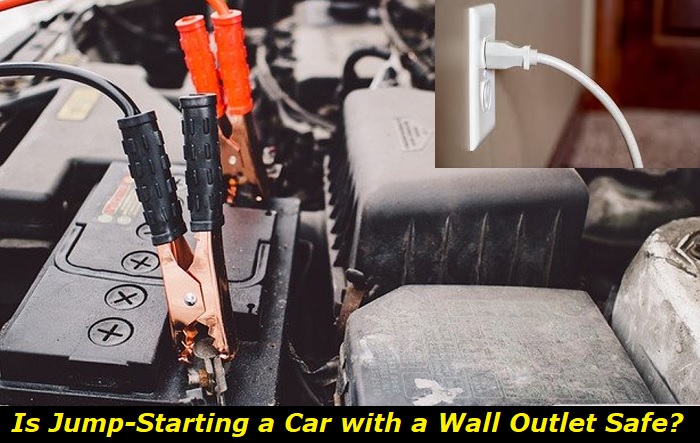You've likely heard about the conventional ways to jump-start a car - using another car's battery or a jump-starter kit. But a wall outlet? It seems almost too easy, doesn't it?
Jump-starting batteries highlights
- When needed:no crank issues
- Time consumed:15-20 minutes
- Toolsneeded:jumper cables or booster
- Risks:car electronics may suffer, battery may die
- DIY solution:yes
- Price:$0

Understanding the Car's Electrical System
Ever wondered what happens under the hood when you jump-start your car? Whether tapping into a neighbor's vehicle or contemplating the wall outlet way, knowing the A to Z of your car's electrical system is vital.
The big players in the game here are:
- The Car Battery
- The Alternator
- The Starter
1) Car Battery
Think of your car battery as the powerhouse that stores electrical energy, similar to a dam brimming with water.
When you turn the key or push the button, this energy is released, kick-starting the starter motor and igniting the engine. It's the spark that brings the sleeping beast to life.
2) The Alternator
The alternator is your behind-the-scenes star in this electric symphony. It helps convert mechanical energy from the engine into electrical energy, keeping the battery up.
It's like the caretaker ensuring the battery, our electrical reservoir, stays topped up so you can rock out to your road trip playlist without killing your car's start-up power.
3) Starter
Next up is the starter, the muscle of the operation that sets the engine's components into motion. When you turn the ignition key, the battery gives the starter a jolt, which revs up the engine.
Getting this interplay is crucial. Whether you go with the conventional or an unconventional method, jump-starting essentially involves temporarily lending power to these components.
Like any loan, it can lead to serious repercussions if done wrong. This is especially true if you're considering using a wall outlet to jump-start your car. But we'll dive into that next.
Traditional Methods of Jump-Starting a Car
Okay, so we've traversed through the complex web of your car's electrical system. Now let's dip our toes into the time-tested ways of breathing life into a car when the battery decides to play dead.
Method 1: Using Another Car's Battery
This method is old school, akin to borrowing a cup of sugar from your neighbor. Only this time, it's energy, not sugar, that you're borrowing. You set up jumper cables from a good battery to your dead one, creating an energy lifeline.
But remember, it's like conducting a rescue mission. There are protocols to be followed. Positive meets positive, negative meets negative, and the cars should never be in physical contact.
Method 2: Using a Jump Starter Kit
Consider this method as your portable energy backup plan, like a spare tire for your battery. It's compact, user-friendly, and doesn't need a second vehicle.
Most come with instructions that are as clear as day. So, even if you've never lifted a car hood, you'll navigate through this just fine.
Regardless of the method, safety must be your top priority. Always suit up with protective gear, ensure that vehicles (if two are involved) are secure, and never attempt to jump-start a leaking or damaged battery.
After all, no deadline is worth putting your safety in jeopardy.
The Idea of Jump Starting a Car Using a Wall Outlet
Having discussed the traditional methods, let's tiptoe into the wilder side of things: jump-starting your vehicle using a wall socket.
So, your car battery has hit rock bottom, and you're fresh out of other vehicles or jump-starter kits. But there's a wall outlet within reach. Tempting, right?
But before you go all MacGyver on your car, we must highlight a key protagonist in this drama: voltage. Your home outlet dances to about 120 volts (if you're in the US) or 230 volts (for our European friends) while your car battery trundles at 12 volts.
Even though it might be alluring to tap into this brimming power source, it also brings safety woes. Dealing with electricity is not as simple as opening a jar or changing a tire.
It's a powerful force that can cause significant damage if not handled carefully. We're referring to the risks of shocks and potential harm to your vehicle's electrical system.
Simply put, trying to jump-start your car using a wall outlet is a move that should be avoided. However, don't worry much, as we will now explore safer alternatives.
Why You Shouldn't Use a Wall Outlet
Let's examine why attempting to start your car from a wall outlet is a terrible idea.
- Considerations: voltage and current differences
- Difference between the specifications of a wall outlet and a car battery
- Potential safety hazards
- Legal and warranty complications
1) Technical Details: Voltage and Current Mismatch
Voltage is the driving force pushing electricity through your wires, while current is the volume of electricity flowing.
2) Difference Between Wall Outlets and Car Batteries
Your household power socket and your vehicle's battery are as dissimilar as chalk and cheese. The wall socket at home operates at a high voltage of 120-230 volts and can dish out substantial current. In sharp contrast, your car's battery plods at 12 volts.
3) Potential safety hazards
Envision a network of cobwebs - your car's electrical system for you. Expose it to a tidal wave of current from the wall socket, and it could crumble like a house of cards. And to add fuel to the fire - mishandling electricity can spark off a potential inferno.
4) Legal and warranty complications
Jump-starting your vehicle from a wall outlet could land you in legal soup. It could also nix your warranty coverage. Car manufacturers lay down specific guidelines for vehicle repairs, and deviating from this course could put your warranty in the firing line.
No mincing words here. Trying to jump-start your car from a wall socket is akin to walking on a tightrope over a volcano - it's fraught with danger, could spell disaster, and the odds aren't in your favor.
Safer Alternatives to Jump-Starting a Car
Let's swerve from the high-risk strategy of using a wall socket to jump-start your car and set our sights on safer alternatives. These options are as smooth and efficient as a well-oiled machine.
1) Using a Portable Jump Starter
Ever thought of using a portable jump starter? It's a small yet powerful device tailor-made for these situations. Think of it as your battery's sidekick - always handy to have around, even if you hope you won't need it.
2) Hiring a Professional Service
Much like reaching out to a locksmith when you're locked out of your home rather than taking a battering ram to the door, roping in professional help ensures your car gets the TLC it deserves.
These professionals have the know-how and the tools to breathe new life into your vehicle, nimbly dodging potential roadblocks.
3) Regular Maintenance of Your Car Battery
And let's not forget the old saying, "A stitch in time saves nine." Regular TLC keeps your car battery purring like a kitten, helping you sidestep jump-start jitters.
So before you even toy with the idea of using a wall outlet to jump-start your car, remember that there are safer, smarter options at your fingertips. They're not just looking out for your vehicle but also for your peace of mind.
Final Thoughts
Before we wrap up our discussion let's take a moment to recap the points. Using a wall outlet to jumpstart your car is extremely risky akin to playing with fire. It's a situation that's just not worth taking any chances with.
There are dangers involved such as the risk of shocks, which can potentially cause damage to your car's sensitive electrical system. Fortunately, there are options much like when you grab an umbrella when unexpected rainfall surprises you.
Always bear in mind that it's much better to prevent problems than have to deal with them, similar to how taking care of your battery regularly is like having a secret weapon against any potential issues.
So, let's prioritize safety and make sure that your journey remains as smooth, as cruising on a maintained highway.
About the authors
The CarAraC research team is composed of seasoned auto mechanics and automotive industry professionals, including individuals with advanced degrees and certifications in their field. Our team members boast prestigious credentials, reflecting their extensive knowledge and skills. These qualifications include: IMI: Institute of the Motor Industry, ASE-Certified Master Automobile Technicians; Coventry University, Graduate of MA in Automotive Journalism; Politecnico di Torino, Italy, MS Automotive Engineering; Ss. Cyril and Methodius University in Skopje, Mechanical University in Skopje; TOC Automotive College; DHA Suffa University, Department of Mechanical Engineering






Add comment